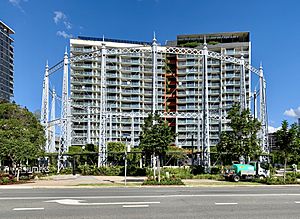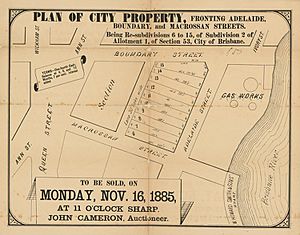Newstead Gasworks facts for kids
Quick facts for kids Newstead Gasworks |
|
|---|---|

Newstead Gasworks, repurposed as an open air amphitheatre, 2020
|
|
| Location | 70 Longland Street, Teneriffe, City of Brisbane, Queensland, Australia |
| Design period | 1870s - 1890s (late 19th century) |
| Built | 1873 - 1887 |
| Official name: Newstead Gasworks No.2 gasholder (remnants) and guide framing, Brisbane Gas Company Gasworks | |
| Type | state heritage (built) |
| Designated | 24 June 2005 |
| Reference no. | 601594 |
| Significant period | 1873-1887 (fabric) 1973-1999 (historical) |
| Lua error in Module:Location_map at line 420: attempt to index field 'wikibase' (a nil value). | |
The Newstead Gasworks is a historic site in Teneriffe, Brisbane, Australia. It used to be a place where gas was made and stored. The main part that remains is the No.2 gasholder, which is like a giant tank for gas. This site was built between 1873 and 1887. It is now protected as a heritage site because it's an important part of Queensland's history.
Contents
Why Was Gas Needed in Brisbane?
In the 1860s, Brisbane was growing fast. More people meant a greater need for services. One big need was for street lighting. Gas was the best way to light up streets back then.
The local council wanted to set up a gasworks. However, the government didn't allow them to build it in a place called Petrie Bight. Instead, in 1864, a private company was allowed to build a gasworks there. This company was the Brisbane Gas Company.
How Did the Brisbane Gas Company Start?
The Brisbane Gas Company began making gas in November 1865. Soon, the streets of Brisbane were lit up! But there were some money problems. The council couldn't pay for the gas, so the lights were turned off for a while. They came back on in 1870 when things got better.
By 1873, the city needed even more gas. So, the company added a bigger gas tank, called the No.2 gasholder. This gasholder was very important.
Important People at the Gas Company
Many people helped the Brisbane Gas Company grow. One key person was Lewis Adolphus Bernays. He was a director and secretary for many years. He was also involved in other important groups in Queensland.
Another important family was the Cowlishaw family. James Cowlishaw, an architect, was the chairman for 41 years! His family members continued to work with the company for a very long time.
Moving to Newstead
As Brisbane grew, the demand for gas kept increasing. The original site at Petrie Bight became too small. So, in 1883, the Brisbane Gas Company bought a large piece of land in Newstead.
The company's engineer, JH Tomlinson, managed the big move. Much of the new equipment came from England. It was brought by ship right to the company's wharf on the Brisbane River. In 1887, the company started making and storing gas at the Newstead site.
The No.2 Gasholder's Journey
The No.2 gasholder, which was built in 1873, was moved from Petrie Bight to Newstead. It was made of a strong material called puddled iron. This shows how important and well-built it was, to be moved and used again.
Competition and New Ideas
In the 1880s, another gas company started in South Brisbane. This led to a "price war" where companies lowered their prices to get customers. Eventually, they decided to split Brisbane into two areas.
Around this time, electricity also started to appear in Brisbane. At first, gas was still used for lighting. But over time, electricity became more popular for lights. Gas was then mostly used for cooking and heating in homes and factories.
How Gas Was Made at Newstead
The Newstead Gasworks had many different machines to make gas. Over the years, the technology changed.
Early Gas Production
When the Newstead Gasworks first opened in 1887, they used large ovens called "retorts." These retorts would heat Ipswich coal to make "town gas." This gas was then cleaned and stored.
Changes Over Time
- In 1920, new vertical retorts were added. These were more efficient.
- Machines were installed to remove things like ammonia from the gas.
- In 1927, the older retorts were updated to work with machines.
- After World War II, the demand for gas grew a lot. New plants were built to make more gas.
- In 1953, an emergency plant was built to make gas from coke. This helped meet the high demand.
The Switch to Natural Gas
In the 1960s, natural gas became available. This was a big change! The old plants that made gas from coal were no longer needed. New plants were built to process natural gas.
By 1996, many older parts of Brisbane were converted to use natural gas directly. This meant the gasworks didn't need to "manufacture" gas anymore.
What Remains Today?
Most of the old gas-making equipment at Newstead has been taken down. The only main part left is the No.2 gasholder structure. It used to hold a huge amount of gas – 500,000 cubic feet!
In 2008, the area around the gasworks was redeveloped. The gasholder site was turned into an outdoor amphitheatre. It's now a place for events and performances.
Why is Newstead Gasworks Important?
The Newstead Gasworks is important for several reasons:
- It shows how Brisbane grew: It tells the story of how gas supply developed in Brisbane from the 1860s. Gas made life much better in the city.
- It's a rare example: The remaining gasholder structure is the last of its kind in Brisbane, and possibly in Queensland. It's a strong reminder of early gas technology.
- It can teach us about history: Studying the site can help us understand how gas was made and supplied over 125 years.
- It shows how gasworks worked: The gasholder shows a key part of how a gasworks operated, storing and delivering gas.
- It looks unique: The round shape of the gasholder is unusual and stands out in the area. It's an interesting and elegant structure.
- It's a local landmark: For over 100 years, people in the area have seen the gasholder. It's a well-known and important landmark for the community.
- It's linked to important people: The site is connected to key figures like Lewis Adolphus Bernays and James Cowlishaw, who played big roles in Queensland's history.
Images for kids



